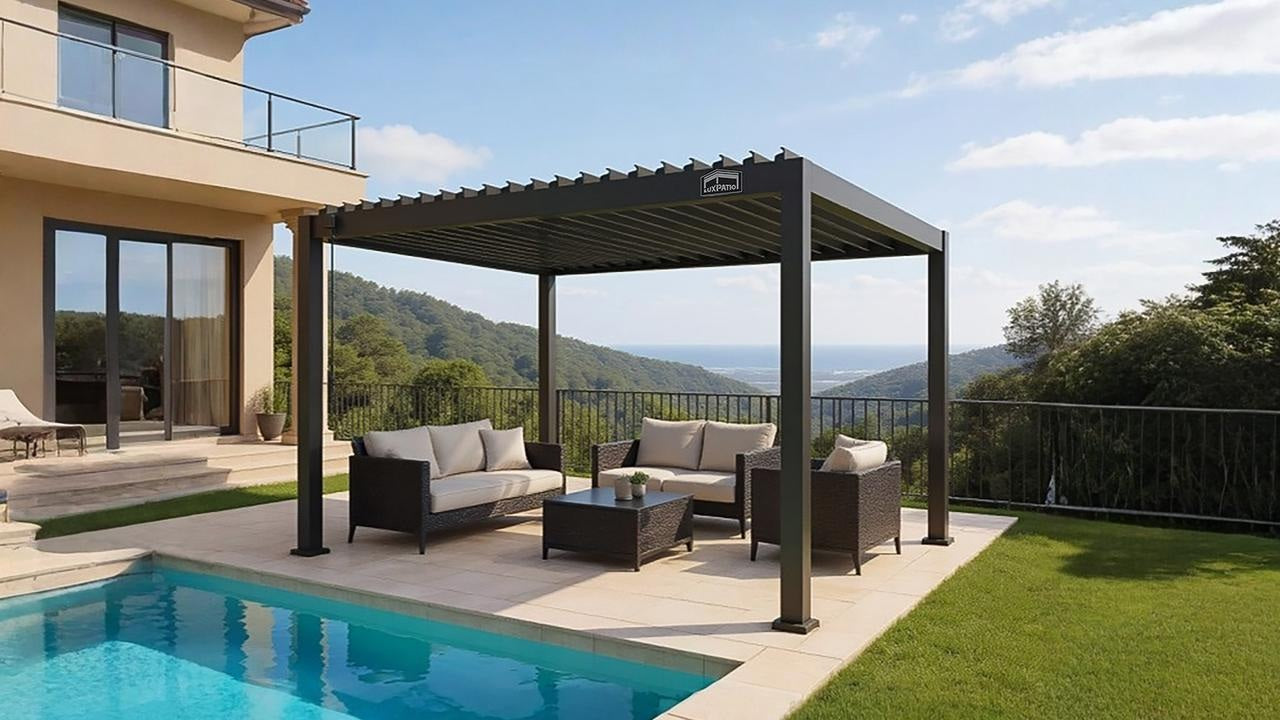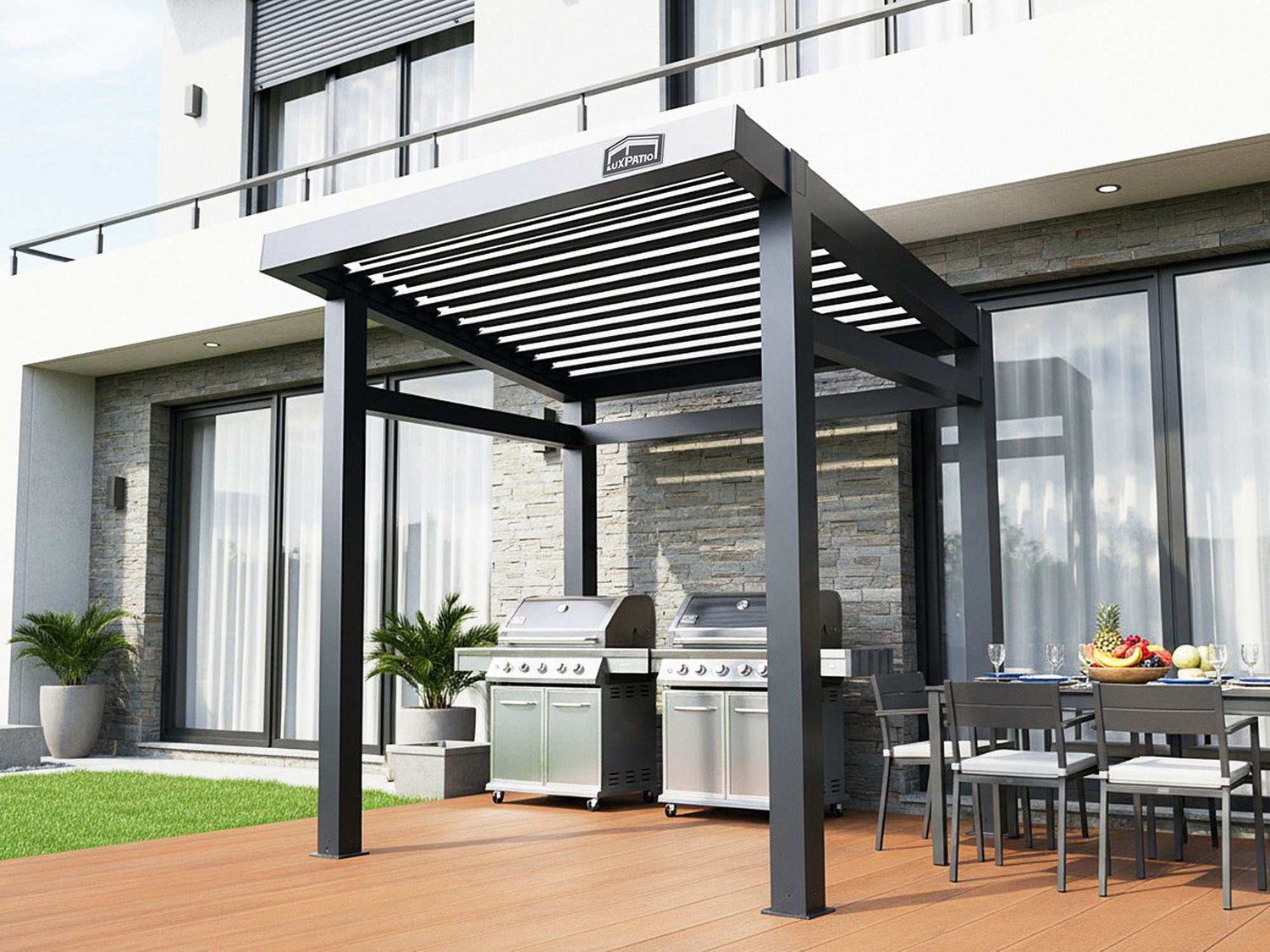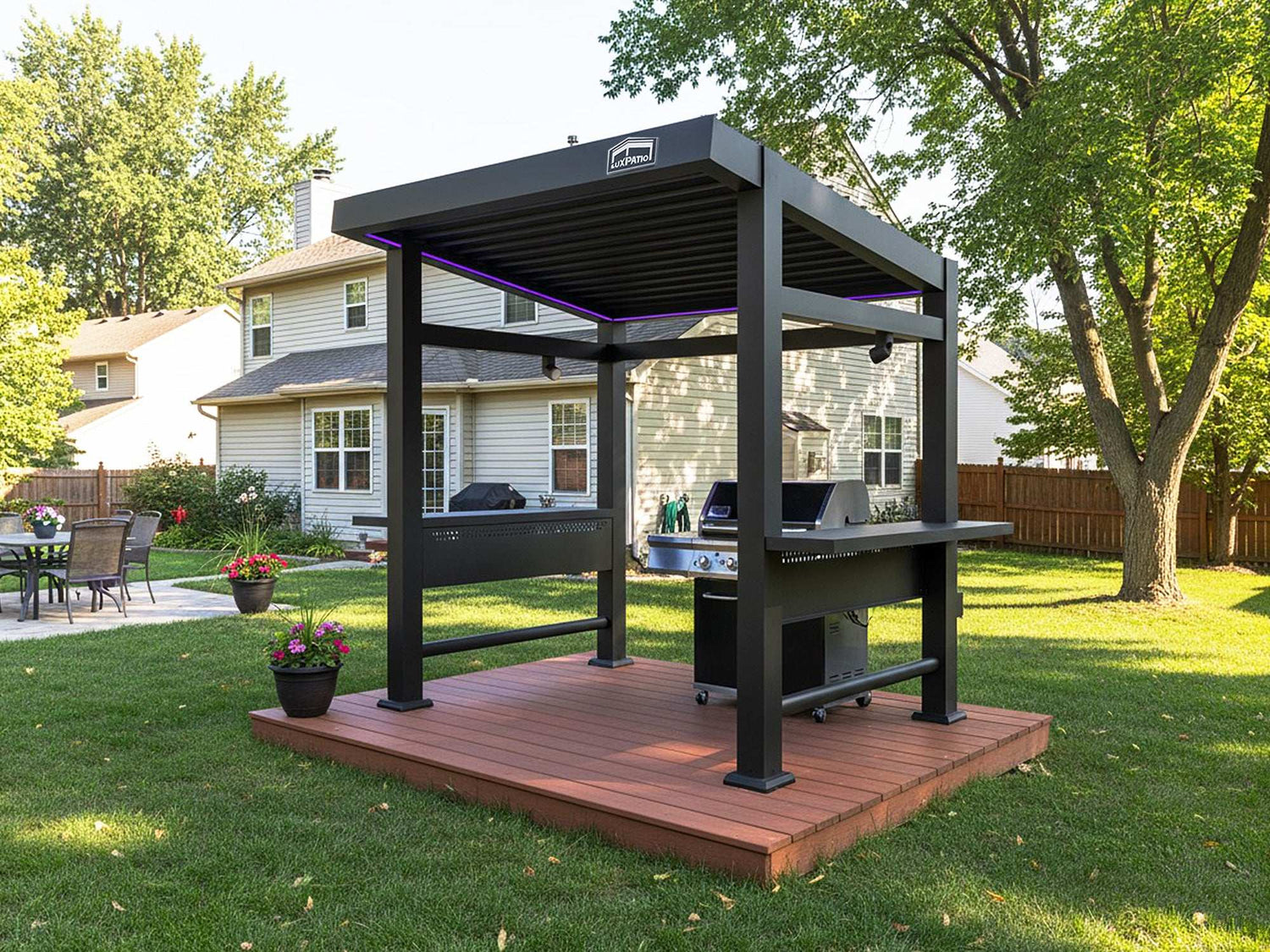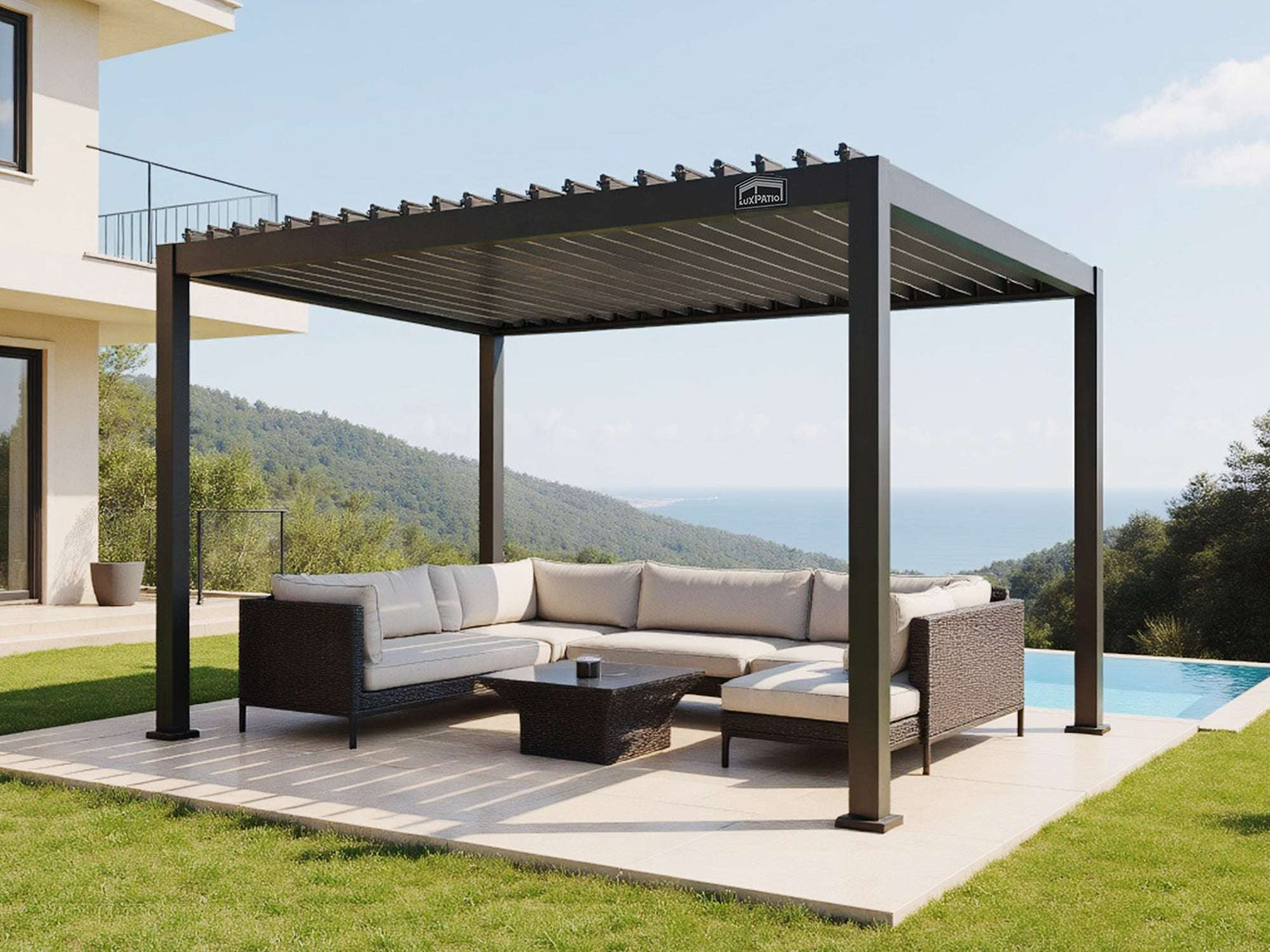
Installing a pergola over a deck is one of the most practical and aesthetic ways to upgrade your outdoor living space. Whether you’re looking to enhance your backyard ambiance, create a shaded lounge, or add structure for outdoor dining, the right aluminum pergola for decking can completely transform your setup. But before diving into installation, there’s a crucial question to answer:
Can your deck actually support a pergola, and how do you choose the right one?
In this guide, we’ll walk you through how to evaluate your deck, choose a pergola that fits both structurally and stylistically, and understand the proper installation process, especially for aluminum louvered pergolas mounted over wood or composite decking.
Contemplating the addition of a pergola over your deck? You’re not alone. It’s one of the most popular home upgrades today, but ensuring your deck is structurally fit and choosing the right materials is key. With lightweight and weather-resistant aluminum options, installation is easier and safer than ever.
Is Your Deck Suitable for a Pergola?
Let’s start with the basics: yes, a pergola can absolutely be attached to a deck, but not every deck is automatically ready for the task.
When you add a vertical load like a pergola, especially a motorized aluminum louvered pergola with tilting roof panels, it puts pressure on specific points of your deck (namely, the footings under each pergola post). These stress points must be supported properly.
Here are the most important factors to assess:
1. Deck Framing and Substructure
-
Most modern decks are built with either pressure-treated wood framing or steel joists. The spacing of these joists (often 16” or 24” apart) determines how much weight the deck can handle and whether additional supports will be needed.
-
Pergolas concentrate weight where the posts are located. You need to ensure that beneath each post location, there is either a joist, beam, or solid blocking to carry the vertical load.
-
For older or DIY-built decks, a structural inspection is recommended before installation. A licensed contractor or structural engineer can help verify load capacity.
2. Decking Material
-
Composite decking is popular for its durability and low maintenance. However, it’s not intended to bear weight alone.
-
You should never mount a pergola post directly into composite planks without securing it through to the subframe. Always anchor through the composite decking into the joists below.
-
Wood decking offers more flexibility for anchoring, but the framing underneath still matters most.
🛠️ Tip: If your joists don’t align with the planned post positions, add blocking or bridging between joists to create solid anchor points.
Why Choose Aluminum for Deck Pergolas?
When mounting over a deck, your pergola's material matters a lot. While wood may have a classic appeal, aluminum pergolas are becoming the go-to choice for modern outdoor builds, especially when installed over raised or framed structures like decks.
Here’s why:
| Feature | Aluminum Pergola | Wood Pergola |
| Weight | Lightweight (~250–300 kg total) | Heavy (often 400 kg or more) |
| Durability | Won’t warp, rot, or rust | Vulnerable to moisture and insects |
| Maintenance | Minimal (no repainting or sealing) | Requires regular staining/sealing |
| Weather Resistance | Excellent (marine-grade options available) | Moderate, needs protection |
| Installation | Easier, pre-drilled kits | Labor-intensive, custom-cut parts |
| Aesthetic Customization | Modern, sleek, motorized options | Traditional look, limited features |
Many homeowners prefer aluminum for its strength-to-weight ratio. It offers the durability of metal without the excess weight of steel. That means less structural stress on your deck, an especially critical consideration if you live in areas with wind, rain, or seismic activity.

Installation 101: How to Attach a Pergola to Your Deck
Proper installation is essential for safety, longevity, and warranty protection. Here's how to install a pergola on decking the right way.
Step 1: Measure and Choose the Right Pergola Size
Start by evaluating your available deck space and how you plan to use the pergola:
-
A 10x10 ft pergola works well for small seating areas or hot tubs.
-
A 12x12 ft pergola can define a full outdoor dining space.
-
For larger decks, modular aluminum kits can be connected or extended.
Choose a pergola that fits proportionally to your deck. A model that’s too large can overwhelm the space, or worse, overload the structure.
Once you’ve chosen your model, request a detailed floorplan layout from your supplier (we include these with all our kits). You’ll use this to mark where each leg will be placed.
Step 2: Check Your Substructure & Reinforce If Needed
-
Locate your deck joists and beams using a stud finder or by checking your deck plans.
-
Ensure each leg of the pergola aligns with a structural member. If it doesn’t, add blocking, short lengths of wood placed perpendicular between joists.
-
In some cases, especially for freestanding or heavy pergolas, you may opt for concrete footings beneath the decking surface. These can be poured through cutouts or planned in advance for new decks.
Step 3: Install the Anchoring System
Most aluminum pergola kits come with mounting plates or brackets designed for deck installation. Here’s the process:
-
Mark the anchor positions based on your floorplan.
-
Drill pilot holes through the decking and into the structural frame (not just the deck boards).
-
Use heavy-duty lag bolts or threaded rods to secure the mounting plates.
-
For concrete footings, use wedge anchors or expansion bolts rated for outdoor use.
alt="aluminum pergola installation on wood decking in Texas"
Step 4: Assemble the Pergola Frame
With the anchor plates secured, it’s time to assemble your pergola:
-
Bolt each aluminum post to the mounting plates.
-
Assemble cross beams and roof components (motorized louvers, fixed slats, or retractable canopies depending on your model).
-
Connect power sources for motorized options like tilting roof blades or LED lighting.
-
Use weather-resistant sealants on any screw joints or exposed wiring points.
Most homeowners complete this step over a weekend with a partner, or hire professionals to handle larger models.

Local Codes and Permits: Don’t Skip This Step
Installing a pergola, especially a permanent or motorized one, may require permits or approvals from your local building authority or homeowners’ association (HOA).
Check for the following:
-
Height restrictions (especially for attached pergolas)
-
Setback requirements
-
Electrical permits (if your pergola includes lighting or motors)
-
Wind/snow load compliance in areas like Florida or Colorado
Skipping permits can lead to penalties or forced removal, so it's always better to be safe.
Common Mistake: Building the Deck First, Pergola Later
Here’s one of the biggest regrets we hear from homeowners:
“I built the deck first, then decided to add a pergola... but now the legs don’t line up with the joists.”
Planning the pergola after the deck is built can lead to major complications. Instead:
-
Choose your pergola model early
-
Use the floorplan to guide your deck's framing layout
-
Ensure joist spacing accommodates anchor points
This proactive approach saves time, money, and frustration.
FAQ: Pergola Over Deck
Q: Can you put a pergola on a raised deck? A: Yes, but it requires careful anchoring. Raised decks need strong footings and reinforced joists under each pergola leg.
Q: Will aluminum rust or fade over time? A: No. Aluminum does not rust and can be powder-coated for UV resistance, making it ideal for humid or coastal climates.
What’s the cost of installing a pergola on a deck?
A: A standard 12x12 aluminum pergola kit typically ranges from $8,200–$11,500. Customized models or additional features may push the price toward the higher end, or beyond, while standard ones remain more affordable. Professional installation usually adds another $1,000–$2,000, depending on your location and deck condition.
Q: Can I DIY this, or do I need a contractor? A: Aluminum pergola kits are DIY-friendly, but deck reinforcements and power connections often require a licensed pro.
Ready to Transform Your Deck?
Installing a pergola over your deck is one of the most rewarding upgrades you can make to your outdoor space. It creates shade, elevates the aesthetic, and even adds value to your home. With lightweight, rust-resistant, and easy-to-install aluminum kits, it’s never been easier to bring your vision to life.










